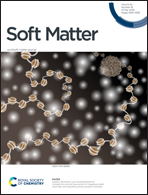How can multi-bond network hydrogels dissipate energy more effectively: an investigation on the relationship between network structure and properties†
Abstract
Constructing a multi-bond network (MBN), which involves hierarchical dynamic bonds with different bond association energies, is an effective method for achieving super tough hydrogels. In this work, a small amount of poly(vinyl alcohol) (PVA) is introduced into a loosely chemically crosslinked poly(acrylic acid) (PAA) network. The hydrophilic PVA chains can physically interact and form hydrogen bonds with the PAA chains. After a freeze–thaw process, PVA could partially crystallize and the generated microcrystals could become new crosslinking points of the hydrogels. Meanwhile, the hydrogen bonds between PAA and PVA, which connect to the microcrystal “core” through PVA chains, could also become new crosslinking points of the hydrogels. The obtained ternary-crosslinked hydrogels (T-gel 10%) exhibit toughness as high as 8 times that in pure PAA hydrogels. When the PVA content exceeds 15 wt%, PVA chains will run through the whole PAA network. Thus the PVA chains will be crosslinked by microcrystals through freeze–thaw treatment, leading to a double network structure, resulting in a brittle hydrogel. The step-increased modulus of the hydrogels with different PVA contents clearly demonstrates the change in the network structure of the hydrogels. Successively, Fe3+ is introduced into the MBN hydrogels as a third cross-linking point. The obtained quaternary-crosslinked hydrogels (Q-gel 10%-Fe5) (50 wt% water content) exhibit significantly improved mechanical properties: tensile strength as high as 6.83 MPa with a fracture energy of 29.9 MJ m−3. This work provides clear insight into the relationship between network structure and mechanical properties in super tough MBN hydrogels.



 Please wait while we load your content...
Please wait while we load your content...